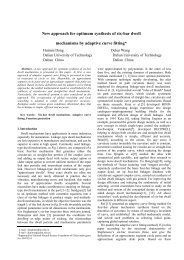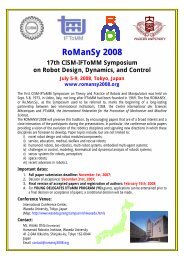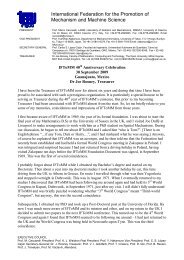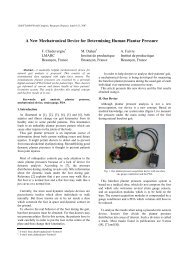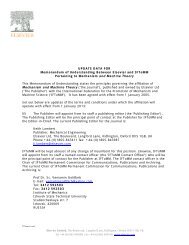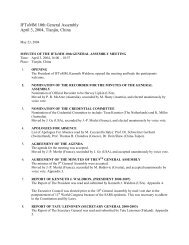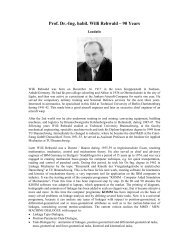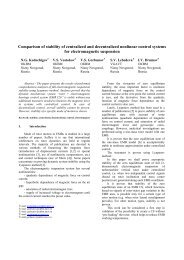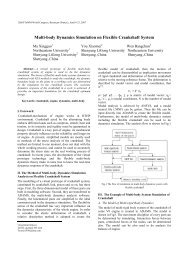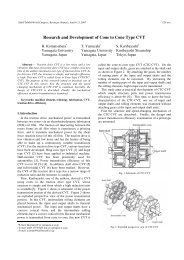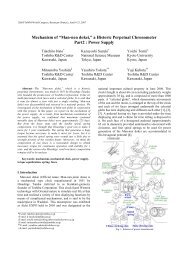A simple technique for measuring the base helix angle of ... - IFToMM
A simple technique for measuring the base helix angle of ... - IFToMM
A simple technique for measuring the base helix angle of ... - IFToMM
Create successful ePaper yourself
Turn your PDF publications into a flip-book with our unique Google optimized e-Paper software.
12th <strong>IFToMM</strong> World Congress, Besançon, June 18-21, 2007 406<br />
span measurement <strong>technique</strong> reported in [7] would<br />
trans<strong>for</strong>m into <strong>the</strong> <strong>the</strong> span measurement procedure<br />
explained in [4] and [5] <strong>for</strong> determining parameters ρ and<br />
s bn (see Eqs. (10)-(12)). Detailed description <strong>of</strong> how <strong>the</strong><br />
remaining two <strong>technique</strong>s should be specialized <strong>for</strong> spur<br />
gears is beyond <strong>the</strong> scope <strong>of</strong> this paper.<br />
V. Numerical example<br />
Application <strong>of</strong> <strong>the</strong> third procedure explained in section<br />
III is here shown with reference to an external involute<br />
helical gear that, upon inspection, has provided <strong>the</strong><br />
following measured data<br />
F<br />
F<br />
F<br />
z = 31<br />
3<br />
4.5<br />
6<br />
= 89.91 mm<br />
= 95.57 mm<br />
= 100.56 mm<br />
(35)<br />
It is hypo<strong>the</strong>sized that <strong>the</strong> three measurements over<br />
balls, F 3 , F 4.5 , and F 6 are taken by standard handheld<br />
micrometers, whose accuracy is usually 0.01 mm. The<br />
three pairs <strong>of</strong> balls are characterized by <strong>the</strong> following<br />
diameters: a 1 =3.000 mm, a 2 =4.500 mm, and a 3 =6.000<br />
mm.<br />
The values <strong>of</strong> e i (i=1,2,3) provided by Eq. (22) are<br />
e = 43.5108 mm<br />
1<br />
e = 45.5935 mm<br />
2<br />
e = 47.3408 mm<br />
3<br />
(36)<br />
(Irrespectively <strong>of</strong> <strong>the</strong> accuracy affecting <strong>the</strong> input data,<br />
intermediate and final results are here expressed by four<br />
decimal digits in order to allow <strong>the</strong> reader to thoroughly<br />
check <strong>the</strong> reported computations.)<br />
Equation (29) is satisfied by <strong>the</strong> following root<br />
ρ = 40.7512 mm<br />
(37)<br />
Finally, linear solution <strong>of</strong> equation set (24) leads to <strong>the</strong><br />
remaining two basic parameters <strong>of</strong> <strong>the</strong> considered gear<br />
β = 26.5641 deg<br />
(38)<br />
b<br />
s = 5.5636 mm<br />
(39)<br />
bn<br />
As already pointed out, <strong>the</strong> value <strong>of</strong> z (Eq. (35)),<br />
toge<strong>the</strong>r with <strong>the</strong> values <strong>of</strong> parameters ρ, β b , and s bn (Eqs.<br />
(37)-(39)) completely define <strong>the</strong> basic geometry <strong>of</strong> <strong>the</strong><br />
inspected gear (i.e., <strong>the</strong> shape <strong>of</strong> <strong>the</strong> involute helicoids and<br />
<strong>the</strong>ir spacing around <strong>the</strong> <strong>base</strong> cylinder). Alternatively,<br />
parameter s bn can be replaced by parameter s b (see Eq. (4))<br />
s = 6.2202 mm<br />
(40)<br />
b<br />
Now <strong>the</strong> attempt will be made <strong>of</strong> estimating <strong>the</strong><br />
ancillary parameters m n , α n , β, and x. For <strong>the</strong> value <strong>of</strong> p bn<br />
provided by Eqs. (3) and (2), by also presuming α n = 20°,<br />
Eq. (30) yields<br />
m = 2.5025 mm<br />
(41)<br />
n<br />
which is very close to <strong>the</strong> normalized value m n = 2.5 mm<br />
([10]). It is <strong>the</strong>re<strong>for</strong>e reasonable to consider <strong>the</strong> inspected<br />
gear as characterized by α n = 20° and m n = 2.5 mm.<br />
Based on Eq. (31), <strong>the</strong> value <strong>of</strong> β is determined<br />
β = 28.4179°<br />
(42)<br />
Finally, Eq. (32) yields <strong>the</strong> value <strong>of</strong> <strong>the</strong> pr<strong>of</strong>ile shift x<br />
VI. Conclusion<br />
x = 0.4464 mm<br />
(43)<br />
The paper has presented two new and easy-toimplement<br />
methods applicable to a helical involute gear<br />
<strong>for</strong> <strong>measuring</strong> its basic geometric parameters and, among<br />
<strong>the</strong>se, <strong>the</strong> <strong>base</strong> <strong>helix</strong> <strong>angle</strong>. Similarly to an already known<br />
procedure, <strong>the</strong> proposed methods require taking two or<br />
three measurements over pins, toge<strong>the</strong>r with one or no<br />
span measurement respectively. Common micrometers<br />
with standard and disc anvils, toge<strong>the</strong>r with pairs <strong>of</strong><br />
calibrated rollers or balls, are <strong>the</strong> only needed inspection<br />
equipment.<br />
Differently from <strong>the</strong> already known method, one <strong>of</strong> <strong>the</strong><br />
proposed methods can be applied to internal helical<br />
involute gears too.<br />
A numerical example has shown application <strong>of</strong> one <strong>of</strong><br />
<strong>the</strong> presented <strong>technique</strong>s to a case study.<br />
References<br />
[1] Townsend, D.P., Dudley’s Gear Handbook, McGraw-Hill, New<br />
York, ISBN 0-07-017903-4, 1992.<br />
[2] Henriot, G., Traité théorique ed pratique des engranages.<br />
Fabrication, contrôle, lubrification, traitement <strong>the</strong>rmique, Dunod,<br />
Paris, 1972.<br />
[3] Gear Design, Manufacturing and Inspection Manual, SAE,<br />
Warrendale, PA, vol. AE-15, ISBN 1-56091-006-2, 1990.<br />
[4] MAAG Gear Book, MAAG Gear-Wheel Company LTD., Zurich,<br />
Switzerland, Zurich, 1963.<br />
[5] Thoen, R.L., Measuring Pr<strong>of</strong>ile and Base Pitch Errors with a<br />
Micrometer, Gear Technology, pp. 42-45, Sept./Oct., 2002.<br />
[6] Thoen R.L., Measuring Base Helix Error on a Sine Bar, Gear<br />
Technology, pp. 25-27, July/Aug, 2001.<br />
[7] Regalado I. and Lopez R., Reverse Engineering <strong>of</strong> Pure Involute<br />
Cylindrical Gears Using Conventional Measurement Tools, Gear<br />
Technology, pp. 32-35, Jan./Feb., 2000.<br />
[8] Colbourne, J.R., The Geometry <strong>of</strong> Involute Gears, Springer-Verlag,<br />
New York, ISBN 0-387-96522-X, 1987.<br />
[9] Litvin, F.L. and Fuentes, A., Gear Geometry and Applied Theory,<br />
Cambridge University Press, ISBN 0-321- 81517-7, 2004.<br />
[10] Cylindrical gears <strong>for</strong> general engineering and <strong>for</strong> heavy<br />
engineering - Modules , Standard ISO 54:1996, 1996.<br />
6



